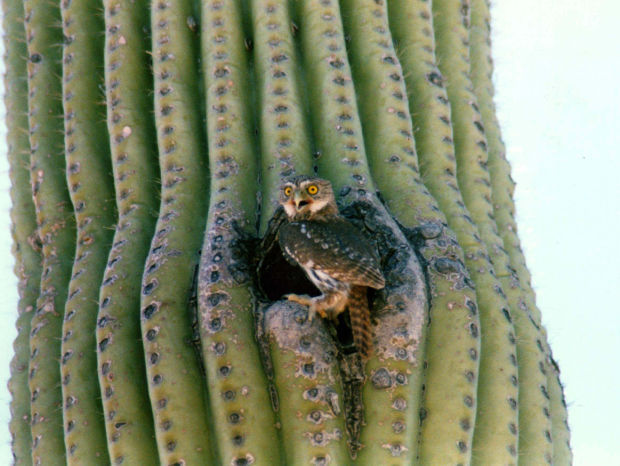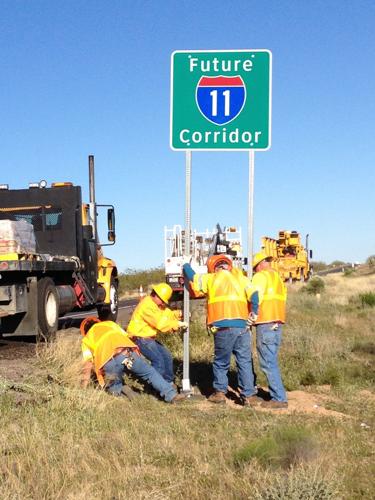An environmental group says Tuesday’s relisting of the pygmy owl as an imperiled species could provide another weapon for opponents of Interstate 11 construction through the Avra Valley west of Tucson.
The U.S. Fish and Wildlife Service announced it will protect the cactus ferruginous pygmy owl as a threatened species in Southern Arizona and southern Texas, due to threats including climate change, habitat destruction and invasive species. The tiny owls top out at 6.7 inches long and weigh 2 to 2.6 ounces. They nest in various trees and cacti including the saguaro and have been known to concentrate in riparian vegetation along rivers and washes.
The listing Tuesday comes a bit more than 17 years since the wildlife service removed the owl from its endangered species list — an action triggered by litigation from homebuilders.
This time, the service was pushed to re-protect the bird — although at a lesser status — by litigation from the Tucson-based Center for Biological Diversity. Its lawsuits also led to the original decision to protect the owl back in 1997.
While the original owl listing resulted in a huge conflict over development in the ironwood forest area on Tucson’s northwest side, much of that land has since been bladed for development, eliminating it as places that could be protected for the owl’s sake.
Also, Pima County Board of Supervisors Chair Adelita Grijalva said Wednesday, since county voters in 2004 approved more than $100 million in bond funding for acquisition of sensitive lands, the county now owns or administers more than a quarter million acres of sensitive lands.
“With the County’s landmark Sonoran Desert Conservation Plan, its companion Multi Species Conservation Plan, and its Section 10 Permit from the U.S. Department of the Interior, relisting of the pygmy owl and any critical habitat designated for it will not result in land-use battles like those of the 1990s and early 2000s,” Grijalva said in a written statement.
But the proposed I-11 route through the Avra Valley is a current target of an environmental lawsuit seeking to block its construction. The interstate would traverse land adjoining Saguaro National Park West and Ironwood National Monument.
Environmentalists are concerned noise and air pollution coming from vehicles using the freeway would negatively effect wildlife, and that the construction would fragment habitat.
“Something like Interstate 11 certainly seems like a threat to pygmy owls and we will continue to oppose it,” said Noah Greenwald, endangered species director for the Center for Biological Diversity.
It’s “a possibility for sure” that the center will add the pygmy owl issue to its litigation against the road’s proposed construction, Greenwald said.
David Godlewski, president of the Southern Arizona Home Builders Association, declined to comment on the new pygmy owl listing, saying, “We’re still evaluating it.”
SAHBA was one of several groups whose litigation led to the wildlife service’s 2006 decision that removed the pygmy owl from endangered species protection.
So far, SAHBA hasn’t taken a position on the Interstate 11 project, he said.
How freeway could be affected
The Arizona Department of Transportation and the Federal Highway Administration have proposed building 280 miles of I-11, running north from Nogales to Wickenburg west of Phoenix. The project — currently unfunded — could cost anywhere from $3.1 billion to $7.3 billion. The agencies say it would be an essential part of a planned roadway corridor stretching from the U.S.’s border with Mexico to the border with Canada.
Without an alternative to Interstate 10 in the Tucson area, traffic will become so congested by 2035 that it will interfere with the region’s ability to function, a former ADOT director, John Haikowski, said in a filing with U.S. District Court last year.

“Further, the success of the state economic development interests will depend on continuing transportation investments, like I-11, to maintain competitiveness,’’ he said then. “Worsened congestion and poor travel time reliability on the interstate freeway system would adversely affect economic competitiveness.’’
But in May, U.S. District Court Judge John Hinderaker of Tucson dismissed a challenge from ADOT and the Federal Highway Administration to a lawsuit filed against the project by environmentalists.
The freeway project could well be affected by the pygmy owl because some part of its financing would have to come from federal money. That provides an obvious trigger for federal intervention in the issue to protect an imperiled species protected by the federal government.
Other development less affected
Development, however, may warrant far less federal attention on endangered species issues now than in the past. That’s because a key legal prompt for federal intervention on a species’ behalf may soon disappear.
In the 1990s and early 2000s, developers in the Tucson area who planned to build near or along desert washes often were required to get a U.S. Clean Water Act permit to build. Because of that, the wildlife service and the U.S. Army Corps of Engineers would often have to review such projects’ effects on endangered or threatened species.
A recent U.S. Supreme Court ruling, however, may make it much harder for federal officials to require such developers to get Clean Water Act permits in the future unless they’re building directly on a navigable waterway. The ruling, known as Sackett vs. EPA, dealt most immediately with wetlands.
Several legal experts have told the Star it could very likely be applied to development along normally dry streams such as those most commonly found in Arizona. That would mean federal agencies would no longer be able to declare that most such streams are legally defined “waters of the U.S.” eligible for federal regulation of development.
The Supreme Court limiting ‘waters of the U.S.’ the way they did is just a disaster for protecting watersheds,” the Center for Biological Diversity’s Greenwald said. “That’s certainly part of the story for how development comes under consideration regarding the pygmy owl.”
Stressors within the owl’s range
Tuesday’s pygmy owl listing by the service would cover far more ground than the land that would be bisected by the proposed interstate and the land within the Tucson metro area, however.
The cactus ferruginous pygmy owls are known to live from Southern Arizona south to Michoacan, Mexico, in the western portion of its range and from Southern Texas to Tamauliipas and Nuevo Leon, Mexico, in the eastern portion of its range.
Arizona, which comprises one of five areas of the Southwest known to contain pygmy owls, currently has the lowest pygmy owl abundance of any of five geographical units into which the wildlife service has split the bird’s natural range.
The owl’s population in this area is estimated to be in the low hundreds, the service said.
Habitat fragmentation and loss from urbanization, and increases in invasive species such as buffelgrass, have reduced both this area’s availability of natural habitat and its ability to be connected with other natural habitats outside this area.
Also, climate conditions have reduced the owl’s prey availability and vegetative cover through increased temperatures and drought, the service’s listing notice said. These factors have made the area’s potential resiliency from environmental damages low, it said.
The northern Sonora area contains a pygmy owl population in the high hundreds, the service said. But the area is affected by habitat fragmentation from urbanization, agricultural development, and associated infrastructure, the service said.
“These stressors increase water use and, in conjunction with climate conditions, result in a reduction in the quality and availability of pygmy-owl habitat,” the service said.
The pygmy owl’s overall geographic range is very large, covering 140,625 square miles in both countries, the service said.
But pygmy owls require habitat elements such as mature woodlands that include appropriate cavities for nest sites, adequate structural diversity and cover, and a diverse prey base, the service said.
All these factors have been negatively influenced by urbanization, invasive species, and agricultural or forest production, the agency said.
Alex Grant, lead zone biologist for the Coronado, gives the call of the Mexican spotted owl during a survey technician training demonstration in the Santa Catalina Mountains. Video Kelly Presnell / Arizona Daily Star





